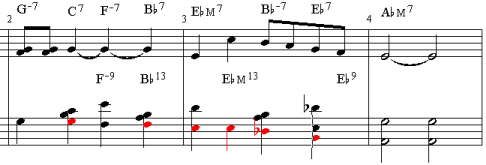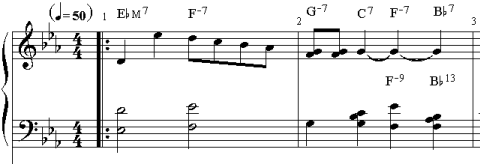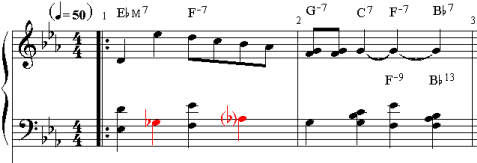Filling in chord notes for the base line
In part four of the arrangement we added chord notes to provide a smooth bass line starting in measure 2 and working through to measure 4. Here's were we left off in adding the bass lines

This is a fairly decent sound that you can produce with the arrangement so far. Most of the chords have 3 or 4 notes and provide a fullness that is pleasing at this point.
I've decide to go back to measure one and connect it into our other two measures. Let's take a look at measure 1 and 2 and see if what we might do to give even more motion to the song.

Enhancing measure 1
As we can see here we have two primary chords of EbM7 and F-7. With the string of notes coming down the Eb scale there should be an option to add a couple of more chords at the beat locations.
The first shot will be moving from the Eb to the F chord. Going through E natural might be an idea, however, we have a Eb in the treble clef and that sets up a dissonant sound right away. We might make that work for us, however, there is another option that we should look at first.
The other option could be to come in from the top by using a G or Gb. I like the idea of a Gb for a couple of reasons. A half step down into the next chord is a nice leading tone. It is likely we can incorporate the Eb into the chord as an extended jazz should like a 13th interval.
So let's change the notes to quarter notes in measure one and add the Gb. Also for beat 4 I'm going to apply the same idea and add a Ab to step down into the G-7 chord at the start of measure 2. The minor third step up from F is close and manageable.

Overall Bass Line movement
I think this keeps the bass line moving smoothly and as we will move from Ab in measure 1 all the way down to the Ab in measure 4 in simple steps while all along changing up the full sound of the chords.
We've done a lot with the bass line to get this arrangement flowing. If you were able to have a bass player with you he or she might play a nice line an octave lower to lay a nice root note to support your chords. You'd be able to even drop the root chord note from your arrangement to fill in with all the color notes. A thorough understanding of music theory is going to be needed to make that type of arrangement work for you.
But I digress, let's get back to the task at hand. We covered a little more today on working out the bass line structure. Next time I'm going to move some notes around and start see if we can enhance our chords with additional notes to get even more richness to the sound.
Here's a suggestion to think about until then. Measure 1 beat 1 has a D in both the top and bottom clefs, we'll need to drop the bass clef and add other notes. What will you do with beat 2 to get a seventh interval involve so we can make the Eb on top a 13th? What might you do with the Eb in the third beat?
Think on it and stay tuned!